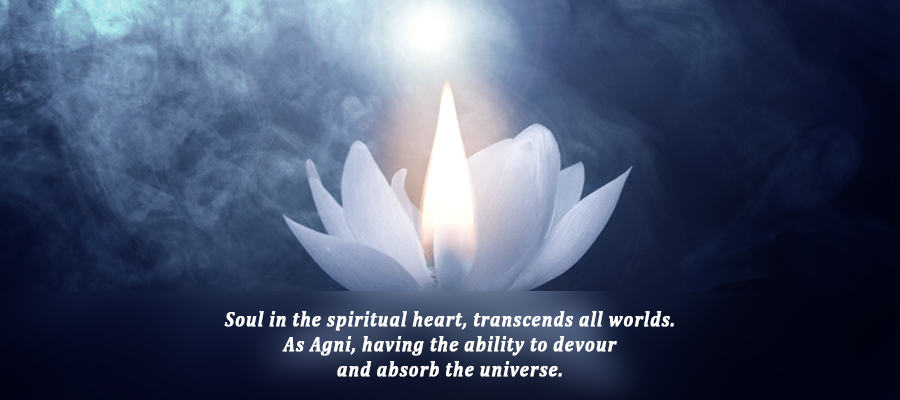Presence and the Present Moment
Yogic teachings emphasize awareness in the here and now, what is often regarded as being in the present moment, not concerned being about the past or the future. This has often been misunderstood. For most of us, being in the present means getting into what is immediately happening around us in the world of the senses. It implies experiencing the moment and its shifting pleasures and pains, which is the pursuit of sensation outwardly, not awareness of Being inwardly. This is to become driven by the stream of external events like a leaf blown by the wind. To be such a creature of the present moment is to have no enduring values in life, caught in the fleeting shadows of the external world.
The true present is not of time. The present that lies between the past and the future is an insubstantial moment that has no reality of its own. It is the most fleeting and insignificant of all things. The true present is the presence of consciousness which observes time but does not change along with time. In that pure presence of Being, the images of time appear like bubbles or clouds that have no real substance of their own. The true present is a state of awareness, not the experiences of the body or mind. It is the state of the witness or observer, not the doer attached to the action.
The way to truth is not to try to hold on to the ephemeral present moment, which does not endure even for an instant, but to remain composed in the eternal presence of consciousness that encompasses all time. The true presence of Being has no form or motion, though it is reflected in all things and holds them like space. To open up to that undying presence is to no longer be disturbed by the transient events around us, which are always uncertain – but to embrace all time as a process of perception of the eternal witness that is the consciousness beyond the mind.
True meditation requires not dwelling in the changing present moment, but dwelling in unchanging presence. Presence is Being, which is in all things, in all time and beyond, in all our states of waking, dream and deep sleep, birth, death and beyond, not just in the images that our senses provide us. You are that presence of consciousness, which is your true nature beyond all karma, the Atman within.
Remain present in your own Being and you will discover that the entire universe will move around you as a dance of bliss. All time and space will be your reflections.
Self Inquiry as Yajna or Fire Sacrifice
The Self in the Vedas and Upanishads is often symbolized by fire (Agni). The Rigveda begins with the worship of Agni, who is the deity of the sacrifice. But who is this Agni and what is the nature of the sacrifice to be offered to it?
There are many forms of Agni in Vedic thought. Agni outwardly as fire and light and inwardly as life and consciousness pervades all things in the universe. In the Vedic view, Agni has three main cosmic (adhidaivic) or world forms as fire, lightning and sun which are the ruling forces in the three worlds of earth, atmosphere and heaven. These are the three lights in the world of nature and the three manifestations of Paramatman, the Supreme Self that is the Divine Light and the light of all the worlds.
In addition, Agni has three main internal (adhyatmic) forms as speech (vak), prana and intelligence (buddhi), which are the ruling forces in the three aspects of our being as body, life and mind. They are the three lights of our internal nature and the three manifestations of the Soul or Jivatman, the consciousness or light principle within us.
These three internal forms of Agni create the three main paths of Yoga practice. Agni’s speech form is the basis of Mantra Yoga or the repetition of sacred sounds like OM or longer prayers like the Gayatri mantra. Mantra practice creates an internal fire that helps purify the subconscious mind and make the mind receptive to meditation. Agni’s prana form is the basis of Prana Yoga or yogic breathing practices of pranayama. Pranayama increases the fire of prana (Pranagni) within us that cleanses the nadis of the subtle body and helps unloosen the knots or granthis of the heart. Agni’s mind form is the basis of Dhyana Yoga or the yoga of meditation. The mind form of Agni or the buddhi is the discriminating part of the mind that allows us to distinguish truth from falsehood, reality from unreality and the Self from the not Self. These three forms of Agni and their related yogic paths take us to the Jivatman or our individual Self and help us understand its basis in the Paramatman or Supreme Self.
There are many Vedic yajnas or fire-sacrifices both external and internal. External yajnas consist of offerings of special substances of wood, ghee, milk or rice into the sacred fire. Internal yajnas consist of offerings of speech (mantra), breath (prana), and mind (meditation) into our internal fires. Vedic Yoga practices of mantra, pranayama and meditation are the main internal yajnas. Yoga itself is the inner sacrifice in all of its forms. The fourth chapter of the Bhagavad Gita explains these different internal sacrifices which reflect the different practices of Yoga including pranayama (Prana-yajna), pratyahara (Indriya-yajna), dharana (Mano-yajna) and dhyana (Buddhi-yajna). Each relates to a different form or aspect of Agni on the levels of body, breath and mind.
The highest Yajna is the Atma-Yajna or Self-sacrifice in which we offer the ego into the Self. This is the also the highest form of meditation or the mind-sacrifice, as the ego is the root of the mind. For this Yajna, the Agni is the Atman or true Self in the heart. Self-inquiry is perhaps the ultimate form of this Atma-Yajna or Self-sacrifice, in which the ego can be directly consumed. It is also called the knowledge-sacrifice (Jnana-yajna) that proceeds through the power of the fire of Self-knowledge (Jnanagni)





